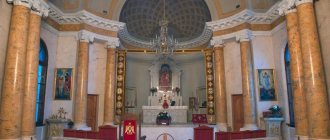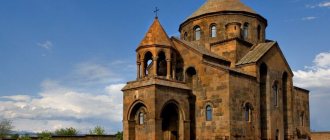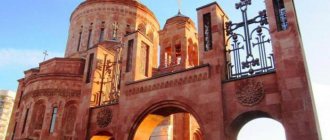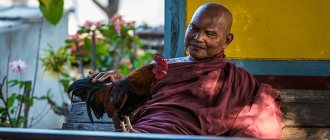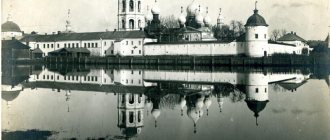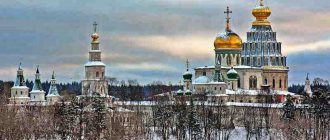Story
In October 1827, a bloody battle between the Russians and the Persians took place in these places. The first prevailed and recaptured the city. Since 1828, the First Poltava Regiment, belonging to the Cossack troops of the Kuban, was stationed in the village of Kanakiry. Initially, they decided to place the church in one of the barracks buildings. On January 29, 1906, the consecration took place in the name of Prince Al. Nevsky.
The construction of the Church of the Intercession in Yerevan dates back to the 20th century. The regiment command decided to build a church for military personnel. Architect Fyodor Mikhailovich Verzhbitsky developed a standard project, according to which at least sixty churches were built in Russia before 1917. It was approved in 1901. In 1913, construction began and lasted three years.
The walls of the Intercession Church are lined with orange tuff. The shape of the building is an octagon on a quadrangle, topped with a large onion-shaped dome. The long refectory adjoins the quadrangle. The side entrances of the refectory have three-lobed pediments. A low bell tower in the form of a tent is installed on a cubic pedestal at the western entrance. On the side of the bell tower, the refectory is crowned with onion domes and decorated with friezes made of kokoshniks.
The Orthodox monastery only worked for a short time: in 1918, the Bolsheviks came to power and the church closed. Initially, it was used as a warehouse, then a club and a cinema for officers were placed in the building, and a little later a hospital was opened in it. Continuing to remain in the department of military personnel, the building was decapitated.
The monastery was returned to the Russian Orthodox in 1991, when Armenia had already become an independent state. The building was restored, the dome was restored, but it no longer corresponded to the original design.
In 2010, a significant event took place in the Church of the Intercession. On March 17, she was visited by two high-ranking clergy: Patriarch of All Rus' Kirill and Patriarch of All Armenians Garekin II. Each of the priests was accompanied by delegations represented by the highest Orthodox dignitaries of the countries. Also present at the ceremony were military personnel assigned to the nearby city of Gyumri.
The Patriarch of All Rus' greeted the parishioners and performed a prayer. Benefactors who actively participated in the restoration were awarded awards from the patriarch.
Archpriest Arseny Grigoryants, rector of the Church of the Intercession of the Most Holy Theotokos, in turn greeted the honorary representatives and presented gifts. Patriarch of All Rus' Kirill received a lamp with semi-precious stones, made of black stone, and Catholicos Karekin II accepted the image of the Most Holy Theotokos as a gift.
Temples and monasteries of Armenia
Faith and religion have always played an important role, both in the life of the tribes - the ancestors of the Armenians who inhabited the Armenian Highlands, and in the life of the already established Armenian people, both in pre-Christian times and after.
The faith that existed in Armenia before the adoption of Christianity underwent great changes over time and went through several stages of development, in parallel with the development of the Armenian people in the Armenian Highlands.
And, starting from the Bronze Age, the tribes that lived in this territory allocated places that they set up for the worship of their gods and deities. These were the first prototypes of temples. The first religious buildings may have been menhirs, cromlechs, vishapakara, etc. Vishapakara, for example, were dedicated to the cult of water.
Religious buildings of the Urartian period were already separate buildings in the form of temples. Thus, the high relief of the chamber of Sarduri II depicts the temple of the supreme god of Urartian mythology - Khald. According to this image, the temple stands on a pedestal base; from the front part there is a columned hall of six columns, which are topped with a triangular pediment.
On the territory of western Armenia, majestic statues of ancient Armenian gods have been preserved. This place is called Nemrut.
Unfortunately, the only pre-Christian Armenian temple that has come down to us is the Garni temple, dedicated to the sun god Migr, who belongs to the next generation of gods of Armenian mythology. Here the supreme god is Aramazd.
Garni Temple was built in the second half of the 1st century BC. The temple belongs to the Greco-Roman peripteros type. In the center of the podium, 2.8 m high and measuring 15.7 * 11.5 m, there is a cella. The cella is surrounded on the front sides by six and on the sides by eight columns. Nine wide steps lead to the entrance.
Unfortunately, the adoption of Christianity led to the loss of a large heritage of pre-Christian places of worship.
After the adoption of Christianity as the state religion in 301, a new stage in the construction of temples and monasteries began in Armenia. Having adopted Christianity first, the Armenians began to independently develop Armenian church architecture. The first Christian churches were built on the sites of old pagan temples, thus linking ancient sacred sites with the new religion. In some cases, old churches were rebuilt, while others were completely destroyed and new ones - Christian churches - were built in their place. The first Christian churches had the same oblong shape - stretching from east to west - as the pre-Christian ones, except that in Christian churches the altar was moved from the west side to the east. It was at this time that those construction, design and artistic principles were formed, on the basis of which all Armenian architecture, as we know it at the moment, is further formed.
The first churches of the 4th-5th centuries were without domes, basilica-shaped - single-nave and three-nave. Some of them may have been of pagan origin, although the only surviving pagan temple of Garni does not lead to such a conclusion. Single-nave churches are generally small in size and modestly decorated. For example, churches in Talin, Tanaat, and so on belong to this type.
Three-nave basilicas have a more complex architecture and date back to the 4th-6th centuries. In this case, a fairly wide prayer hall is divided into three longitudinal naves with the help of pylons, the middle of which is wider. An example of a three-nave basilica is the Yereruyk Church.
After the 6th century, the construction of basilica-type churches almost ceased in Armenia. Armenian architects are working on creating a new - Armenian type of domed churches. Different types of domed churches became leading in church architecture of the 6th-7th centuries. The power of thought and skill of the Armenian architects of that time is evidenced by the various examples of churches that were created at that time. At this time, the entire system of structural forms of the dome was developed. The idea of a dome in church architecture was taken from the design of residential buildings.
It is known that the first churches, such as the Etchmiadzin Cathedral, initially had a wooden covering, then, after reconstruction, a stone dome was built.
In the V-VI centuries, the search for new forms of domed churches continued in two main directions. In the first case, basilicas were taken as a basis to create domed basilicas, basilicas with three sacristies, domed halls, etc. In the second case, centripetal cross-domed churches, with their various options, developed.
The first type includes, for example, the church in Odzun and the Church of St. Gayane in Etchmiadzin. The second type includes churches in Ptgni and Aruch.
Thus, Armenian church architecture, which arose in the 4th century, developed and improved in subsequent centuries, absorbing many techniques from civil architecture, as well as introducing many new ones into it. This is how externally and internally cruciform churches (St. Tadeos in Bagaran), multi-sided churches (Zoravar in Yeghvard), round (multifaceted) churches (Zvartnots) and other forms appear.
In the 9th-11th centuries, after a relative decline, during the Arab conquest of Armenia, construction, including churches, began with renewed vigor. At this time, more attention is paid to decorative arts. The magnificent simplicity of churches of the 7th century is being replaced by a trend of decorating churches. You will get to know these masterpieces by participating in a tour to Armenia organized by our company
Although the dome theme continues to dominate, it takes on new forms. Octagonal domes are replaced by multifaceted (Marmashen, Amberd) and cylindrical domes (Tatev, Haghpat, Sanahin).
The art of decorating churches and artistic stone processing is developing and rising to a new level. New decorative forms appeared - decorations in the form of geometric and floral forms, which reached their perfection in the decoration of khachkars. Fresco painting is also developing. The frescoes in the Tatev, Haghpat, and Akhtamar churches, with their content, harmony of colors and high craftsmanship, are unique examples of monumental painting of that time.
At the same time, separate architectural schools were finally formed, which further developed this art.
Such schools were the Syunik school, the masterpiece of which can be called the Tatev Monastery, the Vaspurakan school (Akhtamar Church, in western Armenia), the Shirak school, with the Marmashen church, the Gugark school, represented by the Sanahin and Haghpat monasteries.
In the XII-XIV centuries, more and more attention was paid to architectural solutions in the construction of auxiliary buildings of monasteries, such as the vestibule, living quarters for monks, libraries, and so on. At this time, the construction of the monasteries of Tatev, Sanahin, Hakhartsin, Haghpat, etc., in the form in which they have come down to us, was basically completed.
An innovation in church architecture of this period are bell towers, which in monastery complexes were built either separately, as in Tatev and Haghpat, or attached to existing buildings.
In subsequent centuries, during the invasion of the Tatar-Mongols, and then the conquest of the Turks and other conquerors, the conditions for the development of churches were not the most favorable. At this time, as in many Christian countries, the church takes on the function of uniting the people and protecting their interests. And despite this, in the 16th-17th centuries both the restoration of churches and monasteries and the construction of new ones continued.
Unlike early medieval monasteries, which were built gradually, over a long period of time, spontaneously, according to the principle of free design and in accordance with natural conditions, late medieval monasteries were built on the basis of a pre-created plan, simultaneously and in a relatively short time. These include the monastery in Mughni, monasteries in Syunik and Artsakh.
In the Middle Ages, after the loss of statehood, not only fortresses, but also monasteries served for defense purposes. Monasteries began to take care of their own security. Both newly built and existing monasteries were surrounded by protective walls.
Throughout the history of Armenia, monasteries played a vital role in the life of the people. Monasteries were religious centers, scientific centers where the great scientists of the time worked, and educational centers. A striking example is the Tatev Monastery, where one of the most famous medieval universities operated. Monasteries were also places where manuscripts were created and the art of miniatures developed.
In the most critical times in the history of the Armenian people, it was the church that was the center that helped unite the people.
Photos
Geghard Cave Monastery
The most visited tourist place is the monastery located in the Geghard cave. The place where the monastery was built in ancient times is sacred - there were many sacred springs here, one of which has survived to this day.
Geghard Monastery
Once upon a time, this cave monastery was just a few cells of monks who retired from the world into novitiate, and today it is one of the main places of pilgrimage in Armenia.
Spear of Destiny in Armenia
The cave monastery became known to the world mainly for one reason - an important relic for the history of Christianity was kept here for centuries - the Spear of Destiny, which killed Christ crucified on the cross.
Interesting! It is believed that the Roman soldier who pierced Jesus showed mercy to him, ending his bodily torment, because the Spear symbolizes victory and the commander into whose hands it falls will always emerge victorious from the war.
It was the spear (in Armenian “Geghard”) that gave the name to the monastery.
What to see in Geghard
Geghard will surprise tourists with several more attractions, including:
- Katoghike Temple;
- a sacristy in the rock, the dome of which is framed from the inside by stalactites;
- Avazan Church and its sacred spring;
- Church of the Mother of God in a cave with ancient reliefs on the walls;
- a chapel carved into the rock dedicated to St. George.
How to get to Gerard
There are no direct flights to Gerard, so it is best to visit Garni first and then take a taxi or walk (about 4 km) to Gerard.
How to get to Etchmiadzin Temple
Echmiadzin Church , part of the Echmiadzin Monastery, is famous for the fact that, according to ancient legend, Christ himself stepped on the altar located in the ancient cathedral, announcing to Grigor Lusavorovich, one of the first Catholics in these parts, to build a temple in this place.
Interesting! The name of the temple - Etchmiadzin means “the descent of the Only Begotten”, and the temple itself is located at a distance of 20 km from the city of Yerevan.
You can get to the temple from the city of Kiliya by minibus No. 203.


